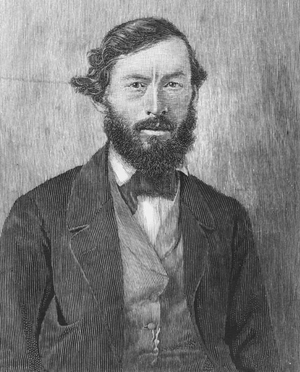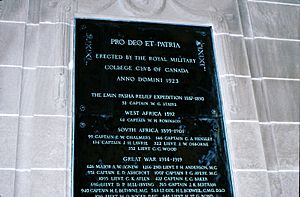John Taylor Wood facts for kids
Quick facts for kids
John Taylor Wood
|
|
|---|---|

John Taylor Wood
|
|
| Born | August 13, 1830 Fort Snelling, Michigan Territory, United States |
| Died | July 19, 1904 (aged 73) Nova Scotia, Canada |
| Allegiance | |
| Service/ |
|
| Years of service | 1847–1861 (USN) 1861–1865 (CSN) |
| Rank | |
| Battles/wars | American Civil War |
John Taylor Wood (born August 13, 1830 – died July 19, 1904) was an important officer during the American Civil War. He served in both the United States Navy and later the Confederate Navy. He became a well-known Confederate naval hero.
He was a lieutenant on the ship CSS Virginia when it fought the USS Monitor in 1862. This was one of the most famous naval battles in American history. In 1865, he was with Confederate President Jefferson Davis' group in Georgia. Wood managed to escape and travel to Cuba. From there, he went to Halifax, Nova Scotia, Canada. He settled there and became a merchant. His family joined him, and he lived the rest of his life in Canada.
Contents
John Taylor Wood's Early Life
John Taylor Wood was born on August 13, 1830. His birthplace was Fort Snelling, which was then in the Northwest Territory. This area is now near St. Paul, Minnesota. Some say he was the first white child born in Minnesota.
His father, Robert Crooke Wood, was an army surgeon. His mother, Ann Mackall Taylor, was the oldest daughter of Zachary Taylor. Zachary Taylor later became a major general in the U.S. Army. He was a hero of the Mexican–American War and the 12th President of the United States (1849–1850).
John Taylor Wood was also the nephew of future Confederate president Jefferson Davis. Davis's first wife, Sarah Knox Taylor, was Zachary Taylor's second daughter.
From 1832 to 1837, Wood's family lived at Fort Crawford. This fort was located where the Mississippi and Wisconsin Rivers meet. Young Wood grew up on the frontier during a time of conflict called the Black Hawk War.
His Family Life
Wood married Lola Mackubin in 1856. They had eleven children together. Their oldest son, Zachary Taylor Wood (1860–1915), became a high-ranking officer in the Royal Canadian Mounted Police (RCMP). He also served as the Commissioner of the Yukon Territory from 1902 to 1903.
Their youngest son, Charles Carroll Wood (1876–1899), graduated from the Royal Military College of Canada in 1896. He served as a lieutenant for Canada in the Boer War. Sadly, he died in battle in 1899. He is remembered on the Royal Military College Memorial Arch and the South African War Memorial (Halifax).
John Taylor Wood's Military Career
John Taylor Wood started his naval career as a midshipman on April 7, 1847. He joined the crew of the ship USS Brandywine and sailed to Brazil. Later, he transferred to USS Ohio. In 1847, he sailed to the west coast of Mexico.
He experienced his first combat when he joined a group of a thousand sailors. They landed to capture the port city of Mazzatan. Wood commanded a gun crew during this attack. After the Mexican War ended in 1848, Wood returned to the Ohio. He served in the new California territory during the California Gold Rush. After three years at sea, his ship returned to Boston.
Fighting the Slave Trade
Wood also served at sea to stop the African slave trade. He was on the ship USS Porpoise patrolling the Gulf of Guinea. His ship captured a Spanish slave ship. Wood was given his first command of a ship. He was ordered to take the captured Africans to Liberia and set them free.
He was in charge of his ship, his crew, and 350 prisoners. The journey lasted three weeks and faced stormy seas. Wood successfully reached Monrovia with his ship and passengers. However, authorities in Liberia would not let him land his cargo in the capital. He had to sail another 150 miles to Grand Bassa. There, he was again told he could not land the former slaves. This time, he did not obey. He used his authority and landed the people. At age 21, Wood gained confidence as a commander from this experience.
Service Before the Civil War
Wood graduated second in his class from the U.S. Naval Academy in 1852. He then served on USS Cumberland for two years, sailing around the Mediterranean. He would later fight against this very ship as a Confederate officer during the Civil War.
In September 1855, he returned to Annapolis, Maryland. He was promoted to lieutenant. In Maryland, he met Lola Mackubin, and they married on November 26, 1856. In 1858, he worked as a gunnery officer for 18 months on USS Wabash.
John Taylor Wood in the Civil War
At the start of the Civil War, Lieutenant Wood was teaching gunnery at the U.S. Naval Academy. Because he supported the Southern states, he resigned from the U.S. Navy on April 2, 1861. He then moved to Virginia. In October 1861, he became a first lieutenant in the Confederate Navy. He was assigned to the ship CSS Virginia in November.
After serving with shore batteries on the Potomac River, he became an officer on the new ironclad ship CSS Virginia. He served under Commander Buchanan. Wood was wounded in the Battle of Hampton Roads. During this battle, he commanded the stern pivot gun. He fired the shot that seriously wounded Lieutenant John Lorimer Worden, the captain of the Monitor.
In May 1862, after the Virginia was destroyed, Wood helped defend Drewry's Bluff on the James River. Over the next two years, Wood led several successful attacks against Union ships. He also worked as a naval helper to Confederate President Jefferson Davis.
In May 1863, he was promoted to commander. At the same time, he held the rank of colonel in the cavalry. These two ranks, along with his brave reputation and family ties to Confederate leaders, allowed him to connect the South's army, navy, and government.
In August 1864, Wood commanded CSS Tallahassee. This was a Confederate ship that attacked Union merchant ships. It was also a blockade runner. Off the Atlantic coast, he captured an amazing 33 Union ships in just ten days near New England.
He was promoted to captain in February 1865. A few months later, as the Confederacy was falling apart, he went with President Davis. They were trying to avoid capture and leave the country.
Even though he was briefly taken prisoner, Wood escaped to Cuba. He then went to Halifax, Nova Scotia. There, he became a businessman. His wife and family joined him, and they lived the rest of their lives in Nova Scotia. Wood died there on July 19, 1904. He is buried in Halifax's Camp Hill Cemetery.
Legacy of John Taylor Wood
- Tallahassee Avenue, Tallahassee Elementary School, and Taylorwood Lane in Eastern Passage are named for Wood and his ship.
See also
- Bibliography of American Civil War naval history
- Military history of Nova Scotia
- Canada in the American Civil War


